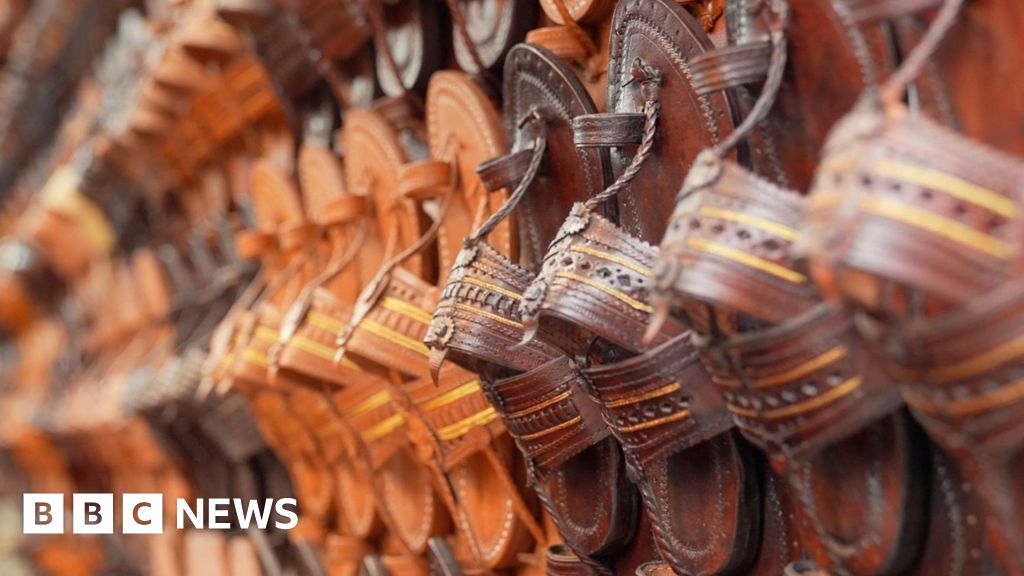【新闻趣读】
意大利奢侈品牌Prada最近摊上大事了!印度传统手工鞋匠们集体"起义",因为他们发现Prada新款凉鞋简直就是自家祖传Kolhapuri凉鞋的"高仿版"。最讽刺的是,这些在印度只卖8美元的纯手工凉鞋,被Prada贴上标签后身价暴涨百倍。58岁老匠人桑纳克听说后灵魂发问:"难道他们往鞋里镶金子了?"现在整个印度手工业界都在喊话:要尊重!要分成!要联名!
'Do they have gold in them?': The Indian artisans up in arms over Prada's sandals
"鞋里镶金了?":印度工匠抗议Prada凉鞋抄袭
4 July 2025 Share Save Devina Gupta BBC News Reporting from Kolhapur, Maharashtra Share Save
2025年7月4日 记者德维娜·古普塔发自印度马哈拉施特拉邦科尔哈布尔
BBC The earliest records of Kolhapur sandals date back to the 12th Century.
BBC:科尔哈普里凉鞋的最早记录可追溯至12世纪
The rhythmic pounding of the hammer in 58-year-old Sadashiv Sanake's dimly lit workshop bears witness to the hard grind behind handcrafting the iconic Kolhapuri leather sandals.
58岁萨达希夫·桑纳克昏暗作坊里规律的锤击声,见证了标志性Kolhapuri皮凉鞋背后的艰辛。
"I learnt the craft as a child," he tells the BBC. A day's toil goes into making just"eight to 10 pairs" of these sandals he says, that retail at a modest $8-10.
"我从小学习这门手艺,"他告诉BBC。制作"8到10双"凉鞋需要一整天劳作,而每双仅售8-10美元。
Barely 5,000 artisans in Kolhapur are still in the profession – a cottage industry that struggles to compete in a mechanised world, caught in the funk of dismal working conditions and low wages.
科尔哈布尔仅剩不到5000名工匠仍在坚守——这个家庭手工业在机械化时代举步维艰,深陷恶劣工作条件和低收入的困境。
It's no surprise then that when Italian luxury brand Prada released a new line of footwear that bore a striking resemblance to the Kolhapuri sandals - but didn't mention the design origins - local artisans were up in arms.
因此当意大利奢侈品牌Prada推出与Kolhapuri凉鞋惊人相似却未注明设计渊源的新品时,当地工匠的愤怒可想而知。
Reuters Prada's leather footwear at the Milan Fashion Week sparked a major controversy
路透社:Prada在米兰时装周发布的皮凉鞋引发巨大争议
The backlash was swift. Social media was flooded with accusations of cultural appropriation, prompting Prada to issue a statement acknowledging the sandals' roots.
反弹来得迅速。社交媒体上文化挪用的指责铺天盖地,迫使Prada发表声明承认凉鞋渊源。
Now local politicians and industry associations have thrown their weight behind the artisans who want better recognition of the craft and its cultural legacy.
如今当地政要和行业协会都支持工匠们争取对手工艺及其文化遗产的更好认可。
Mr Sanake was not aware of Prada's show until the BBC showed him a video of it. When told that that the sandals could retail for hundreds of pounds in luxury markets, he scoffed.
直到BBC展示视频,桑纳克才知晓Prada的发布会。听说这些凉鞋在奢侈品市场售价数百英镑时,他嗤之以鼻。
"Do they have gold in them?" he asked. Prada hasn't revealed the price tag but its other sandals retail at between £600 to £1,000 in the UK as per its website.
"难道鞋里镶金子了?"Prada未公布具体售价,但其官网显示其他凉鞋在英国售价600至1000英镑。
Women try on Kolhapuri sandals at a store in Kolhapur
女性顾客在科尔哈布尔商店试穿Kolhapuri凉鞋
The earliest records of Kolhapur sandals date back to the 12th Century.
Kolhapuri凉鞋的最早记载可追溯至12世纪。
"These sandals were originally crafted by members of the marginalised Charmakar (cobbler) community, also known as chamars," said Kavita Gagrani, a history professor at the New College in Kolhapur.
"这些凉鞋最初由边缘化的Charmakar(制鞋匠)社群成员制作,"科尔哈布尔新学院历史教授卡维塔·加格拉尼说。
Chamar is a pejorative caste term used to describe Dalits (formerly known as untouchables) who work with animal hides.
Chamar是贬义种姓术语,指代处理动物皮革的达利特(旧称"不可接触者")。
"But in the early 20th Century, the craft flourished when the then ruler of Kolhapur, Chhatrapati Shahu Maharaj granted royal patronage to this community," Ms Gagrani said.
"20世纪初,当时的科尔哈布尔统治者沙胡·马哈拉贾授予这个社群皇家赞助,这项工艺得以繁荣,"加格拉尼说。
Today, nearly 100,000 artisans across India are engaged in the trade with an industry worth over $200m, according to the Maharashtra Chamber of Commerce, Industry & Agriculture (MACCIA), a prominent industry trade group.
据马哈拉施特拉工商农会(MACCIA)数据,全印度近10万工匠从事该行业,产值超2亿美元。
Yet, most of them continue to work in unorganised setups under dismal conditions.
但大多数人仍在恶劣条件下从事非正规生产。
"I was never educated. This is all I know, and I earn about $4-5 a day, depending on the number of orders," said 60-year-old Sunita Satpute.
"我没受过教育。这是我唯一的技能,每天赚4-5美元,"60岁的苏尼塔·萨特普特说。
Women like her play a critical role, particularly in engraving fine patterns by hand, but are not compensated fairly for their long hours of labour, she said.
她说女性工匠在手工雕刻精细图案方面至关重要,却未获合理报酬。
That's why Sunita's children don't want to continue the craft.
因此她的子女不愿继承这门手艺。
A short distance away from her workshop lies Kolhapur's famous chappal gully, or sandal lane, a cluster of storefronts - many of them struggling to stay afloat.
距她作坊不远处是著名的"凉鞋巷",许多店铺艰难维持。
"Leather has become very expensive and has pushed up our costs," said Anil Doipode, one of the first sellers to open a shop here.
"皮革价格飞涨推高了成本,"首批在此开店的阿尼尔·多伊波德说。
Traditionally, artisans would use cow and buffalo hide to make these sandals.
传统上工匠使用牛皮和水牛皮制作凉鞋。
But since 2014, when the Hindu nationalist Bharatiya Janata Party (BJP) came to power, there have been several reports of vigilantes - self-appointed protesters or activists - cracking down on alleged cow slaughter, sometimes with physical violence.
但自2014年印度人民党执政以来,多次发生民间组织暴力打击疑似宰牛事件。
The cow is considered sacred by Hindus.
印度教视牛为神圣。
In 2015, Maharashtra state banned the slaughter of cows and the sale and consumption of beef, forcing artisans to rely on buffalo leather sourced from neighbouring states, pushing up their production costs.
2015年马哈拉施特拉邦禁止宰牛及牛肉销售,迫使工匠依赖邻邦水牛皮,推高了成本。
Traditional sellers are also struggling to compete with synthetic copies flooding the market.
传统卖家还面临充斥市场的合成仿制品竞争。
"Customers want cheaper sandals and can't always tell the difference," said Rohit Balkrishna Gavali, a second-generation Kolhapuri sandal seller.
"顾客想要更便宜的凉鞋,且无法分辨真伪,"第二代Kolhapuri凉鞋卖家罗希特说。
Women artisans engrave fine patterns in the leather sandals by hand
女性工匠手工雕刻皮凉鞋上的精细图案
Industry experts say the controversy highlights the need for a better institutional framework to protect the rights of artisans.
行业专家称此争议凸显需要更好制度框架保护工匠权益。
In 2019, the Indian government had awarded Kolhapuri sandals the Geographical Indication (GI) - a mark of authenticity which protects its name and design within India, preventing unauthorised use by outsiders.
2019年印度政府授予Kolhapuri凉鞋地理标志(GI),在印度境内保护其名称和设计。
Globally, however, there is no binding law that stops other countries or brands from aesthetic imitation.
但在全球范围,尚无法律禁止他国或品牌进行美学模仿。
Aishwarya Sandeep, a Mumbai-based advocate, says that India could raise the issue at the World Trade Organization under its TRIPS (Trade-Related Aspects of Intellectual Property Rights) agreement, of which it is a signatory.
孟买律师艾西瓦娅·桑迪普称印度可在WTO的TRIPS协议下提出此问题。
But the system is cumbersome, expensive and often lacks enforceability, both in India and abroad, she adds.
但她补充该体系繁琐昂贵且执行力不足。
Lalit Gandhi, the president of MCCIA, says his organisation is planning to patent the Kolhapuri sandal design, hoping to create a legal precedent for future cases.
MACCIA主席拉利特·甘地称计划为Kolhapuri凉鞋设计申请专利,为未来案例创法律先例。
But some say real change can only happen when India starts seeing its traditional heritage in a different light.
但也有人认为只有当印度以新视角看待传统遗产,才能真正改变。
"It's about ethical recognition. India must push for royalty-sharing and co-branding," says Ritu Beri, a renowned designer.
"这关乎道德认可。印度必须争取分成和联名,"著名设计师里图·贝里说。
"The more we take pride in our culture, the less we will be exploited."
"越以文化为荣,就越少被剥削。"
Kolhapur is home to thousands of artisans who have been making these sandals for generations
科尔哈布尔是数千代代相传制作这种凉鞋的工匠的家园

